14.04.23
On taste: Bruichladdich, Cu Bocan Creation #5; Cutty Sark Launches 100th Anniversary Cocktail List
Hello everyone
Samples awaited did indeed turn up and I‘ve had a happy time nosing and tasting.
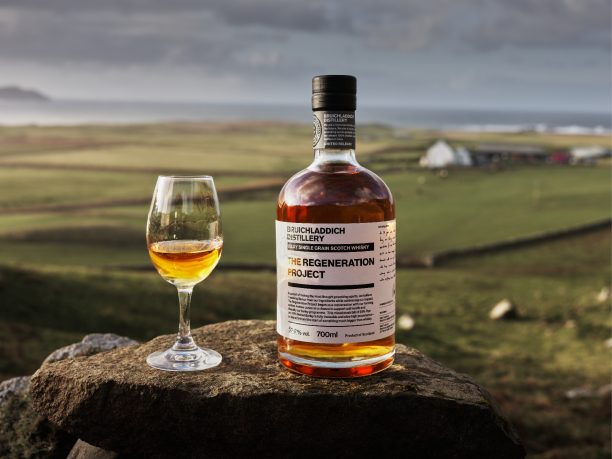 Let‘s start with Bruichladdich The Regeneration Project (50% abv; NCF/NAC; first fill bourbon wood and first fill virgin U.S. oak) of which only 1800 bottles were produced. It‘s £125 a bottle from the Bruichladdich online shop. From the live online chat session last week, there seems a chance there might be more or something similar in future. Maybe an older version. It is described as a single grain whisky composed of 55% rye and 45% malted barley, from one single distillery. 30 casks were filled and 6 used for this bottling. Some of those empty casks will be used for Bruichladdich maturation. Rye whisky from subsequent years has been moved into other casks and some Octomore has gone into rye casks. One smart person suggested a Rye Black Art. I like that idea but only Adam will know if it would work. The casks were toasted, not charred, as Master Distiller Adam Hannett wanted the grain to be the star.
Let‘s start with Bruichladdich The Regeneration Project (50% abv; NCF/NAC; first fill bourbon wood and first fill virgin U.S. oak) of which only 1800 bottles were produced. It‘s £125 a bottle from the Bruichladdich online shop. From the live online chat session last week, there seems a chance there might be more or something similar in future. Maybe an older version. It is described as a single grain whisky composed of 55% rye and 45% malted barley, from one single distillery. 30 casks were filled and 6 used for this bottling. Some of those empty casks will be used for Bruichladdich maturation. Rye whisky from subsequent years has been moved into other casks and some Octomore has gone into rye casks. One smart person suggested a Rye Black Art. I like that idea but only Adam will know if it would work. The casks were toasted, not charred, as Master Distiller Adam Hannett wanted the grain to be the star.
It‘s called Regeneration as planting rye is a useful rotational crop for farmers. It puts nutrients back into the soil that are good for barley grown in the same field the following year. The farmer partner, Andrew Jones, said that a lot less fertiliser was needed for the barley crop if it was preceded by rye.
I decided I was doing my own notes before the broadcast as I didn‘t want mine to be influenced by what I heard. Nosing straight from the sample bottle, I got oak, vanilla and earth. From the empty glass afterwards, there were oak and toast. And from the glass?
Appearance: Light tawny (lion-coloured) and rich gold with some brass highlights. Tears fairly slow to form and quite widely spaced.
Nose: Fresh; some floral notes (a bit like the Floral Gum sweets I sometimes had as a child); honey; sweet spiciness – mace and mixed spice for me; oak and vanilla; earthen floors; melon – really ripe but not overly so; some salty sea air.
With water, more spice to the fore and some young spirit notes; a bit of yeast and some citrus zest; toastiness and some nuttiness. Little bit of licorice.
Although this is only 5 years old and there was a waft of youth, it has a lovely mellowness and depth for its age. [Remember age is important but not everything.]
Palate: Slightly viscous mouth feel. Sweet at first then peppery and quite mouth-drying (it‘s the rye) and tongue-tingling. Licorice again; oak and vanilla; spices; malted grain sweetness from the barley; toasty oak and dark chocolate bitterness.
Finish: Medium length. Peppery with grain sweetness at the back; sweet oak and ending dry with notes, bitters/dark chocolate.
I found this to be an enticing dram and would very much look forward to more bottlings, should Adam decide to play with different ages and 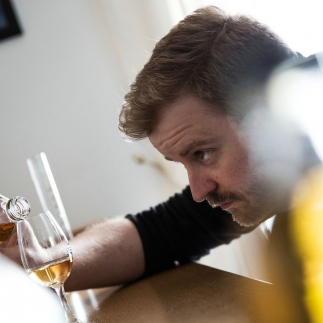 grain mixes. He did say the rye was harder than barley to work with as it gets a bit syrupy in the mashing equipment and that a 4 tonne mash of rye might take 15 hours as opposed to 9 for the same quantity of barley. As they also work with bere barley which isn‘t as easy to use as regular barley, I wondered which is the harder one to work with, rye or bere barley. Adam was kind enough to answer me as follows:
grain mixes. He did say the rye was harder than barley to work with as it gets a bit syrupy in the mashing equipment and that a 4 tonne mash of rye might take 15 hours as opposed to 9 for the same quantity of barley. As they also work with bere barley which isn‘t as easy to use as regular barley, I wondered which is the harder one to work with, rye or bere barley. Adam was kind enough to answer me as follows:
„Which is harder to work with, Bere or Rye? – I would say in terms of production the rye is more difficult, because there is no husk and the high beta-glucan content makes the mash quite sticky so all in all it is very hard to deal with in the mash tun. The drainage is very hard to achieve and there is less accessible sugar as the rye isn’t malted so the yields are quite low in comparison to malted barley. So at the mashing stage we are beset with difficulties but by mashing in the rye first at higher temperature and mixing it to gelatinise the grain until we add the malted barley at lower temperature to allow the enzyme in the malt to work as much as it can, we get a the best we can from the rye. Then by altering our usual process of drainage to the washbacks we get as much as we can to take for fermentation. It isn’t easy but we have learned and adapted each time we have worked with the rye and we still have some other tricks up our sleeve for the next batch we make!
The Bere barley is also difficult to work with but this is more to do with the small grain size and the proportion of husk is higher so the grain is lighter and when in the mashtun much bulkier but it does drain well and behave itself!
Ultimately though the pursuit of new flavours, genetic diversity in barley and more sustainable farming techniques mean that both the rye and bere are both really important to us and that the fact it isn’t easy is no reason not to do it, the broader benefits make it really worth while.“
So there you have the expert‘s answer and useful, I hope, to those of you studying the process of whisky making a bit more closely. A huge thanks to Adam for this response.
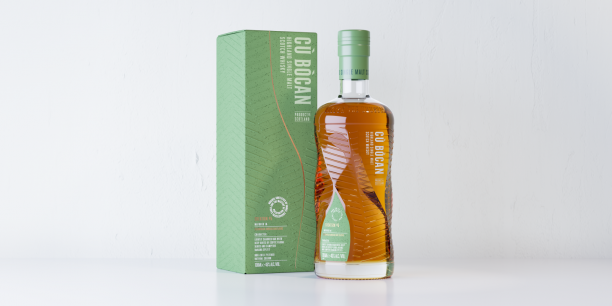 The other whisky I was looking forward to trying this time is the Cu Bocan Creation #5 Matured in Colombian Andean Oak from Tomatin Distillery. It‘s bottled at 46% abv and a sample of Cu Bocan Signature (matured in Bourbon, Oloroso and North American Virgin Oak and also at 46%) was included so I was able to contrast them. The Creation #5:
The other whisky I was looking forward to trying this time is the Cu Bocan Creation #5 Matured in Colombian Andean Oak from Tomatin Distillery. It‘s bottled at 46% abv and a sample of Cu Bocan Signature (matured in Bourbon, Oloroso and North American Virgin Oak and also at 46%) was included so I was able to contrast them. The Creation #5:
Appearance: Rich, autumnal gold; brass highlights. Tears fairly swift and close at first then more widely spaced.
Nose: From the bottle at first, a light touch of gentle oak wood sugar sweetness from the charring and some baked honey.
In the glass, warm and spicy; baked bananas + ripe banana skin and vanilla; honey; night jasmine.
With water, more cream and fruitiness at first; some sultana sponge and soft ginger spice. Just a little subtle smoke and still the wood char; candied nuts.
It noses as a little denser and deeper than Signature for me.
Palate: Slight viscosity. Warm, spicy, peppery. Certainly smoke on palate but subtle and well-integrated. Some herbal dryness and licorice here too. Banana skin ripeness and some tannins. The char shows up on the palate as more of a bitter note than the sweetness it gave on the nose.
Finish: Medium – long, peppery, herbal and dry with a touch of char.
By contrast, I found the Signature a little paler than Creation #5. It had oak, spice and vanilla on the nose from the bottle and in the glass 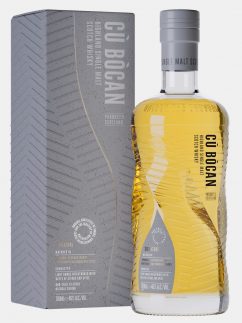 opened out to be lighter and fresher than its sister expression. Some salt air though it‘s not close to sea. More savoury than sweet at first. Some light fruit but also leafy and a hint of fresh peanut. With water, there were waxier notes and softer; cream cheese and sherbet lemons. There‘s light smoke on the palate here too with the same sherbet lemon I sensed on the nose (and quite sherbety/prickly on the tongue); licorice, oak and tannin and softer, more savoury spices. It also finishes fairly long and dry with soft smoke and a little char.
opened out to be lighter and fresher than its sister expression. Some salt air though it‘s not close to sea. More savoury than sweet at first. Some light fruit but also leafy and a hint of fresh peanut. With water, there were waxier notes and softer; cream cheese and sherbet lemons. There‘s light smoke on the palate here too with the same sherbet lemon I sensed on the nose (and quite sherbety/prickly on the tongue); licorice, oak and tannin and softer, more savoury spices. It also finishes fairly long and dry with soft smoke and a little char.
Do I have a preference? A hard one as I‘d happily drink either but maybe on different occasions dependent on mood. If pushed, I‘d go (just) for the Creation #5. There are only 8,400 bottles to cover key markets round the world and, at UK pricing, expect to find it in specialist stores at around £60 per 70cl bottle.
Penultimate mention this time goes to Cutty Sark. The brand celebrates the 100th anniversary of its creation this year. Those who know your history may recall that the Cutty Sark ship was a tea clipper on the oceans from the second half of the 19th century so the brand people have commissioned 100th birthday cocktails to celebrate the ship. They‘ve been created in partnership with The Tea Leaf Company and launched just in time for National Tea Day on 21st April. I‘ve never heard of this day before but, as an enthusiastic tea drinker I support it pretty much every day. Now, I was sent a sample box with a bottle of Cutty, a lemon, some soda water and some tea to create one cocktail, the CuTEA Clipper.
Apparently the Cutty Sark returned from China with enough tea on board for 200 million cups. A bit more than I manage in a year. We‘re told „The sweet, orchid-like flavour of…No. 07 Ti Kuan Yin Chinese Oolong“ mixed with Cutty Sark creates a perfect end of day relaxing drink. Recipe is:
CuTEA Clipper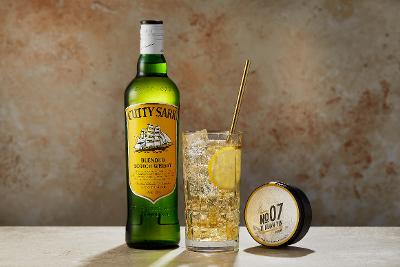
50 ml Cutty Sark whisky
50ml brewed The Tea Leaf Co. Ti Kuan Yin Chinese Oolong tea
Soda water
Lemon
Preparation:
Stew the tea leaves in a cup of hot water for 3 minutes, leave to cool. Add the whisky and tea to a highball glass filled with ice and stir to combine. Top with soda water and garnish with a lemon wheel.
Now, it doesn‘t say how much tea to use nor how much water for brewing it but it would doubtless be to personal taste dependent on how strong you want the tea part to be. I haven‘t yet had the chance to play with the kit but intend to do so this weekend and will let you know next time how it tastes.
Lastly, a note in from Caol Ila and Lagavulin today to say that their Feis Ile event tickets are now on sale online. I suspect they‘ll have been snapped up mega-quickly but, if you are on Islay for Feis at end of May then have a look, just in case. I‘ll be over, as usual (ferry breakdowns permitting), from Wednesday – Friday to do my Thursday night dinner at The Port Charlotte so I won‘t be around to attend these but I never have time to attend things when I‘m there anyway!
 Till end of April, happy dramming.
Till end of April, happy dramming.
Slainte,
Caroline
Comments